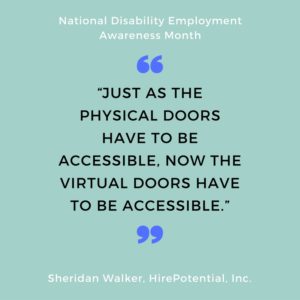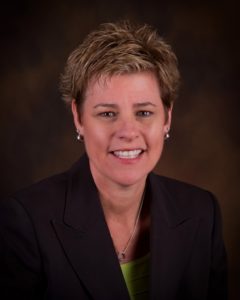The following post was authored by Sheridan Walker and is being shared with permission from our partner, HirePotential, Inc.
We know that we need to provide accommodations for individuals with disabilities in the application process, but how about accessibility? Is it really necessary to go that far?
Consider the following example. To make a restroom accessible, we would want to make it large enough for a wheelchair and provide handrails. We would adjust the toilet roll holder to the proper height and install automatic flushing. We might even provide a button to the side of door, to make it easier to open.
Now suppose we didn’t have the funds to make the restroom accessible. We just want to provide an accommodation. What would that look like? Whatever you imagine, it probably won’t provide a wheelchair-bound person what they need to be independent.

Most people apply for positions when they are not at their regular place of work. This would include the lunch hour, evenings, and weekends. In fact, most requisitions close at midnight, and there is a flurry of activity the evening of the closing date of a requisition. If the accommodation offered is not available at the times most needed, is this really an accommodation?
One option is to provide an extension to people who need an accommodation. But is this the level of recordkeeping you want to handle? If you consider applicants after the close of the requisition, an enforcement agency could infer that all applicants who apply after the close of the requisition should be considered for that position. To rebut the presumption, you would have to provide additional documentation to demonstrate that only those individuals requesting an accommodation received an exception. Another option is to provide 24/7 accommodation line offering equal access in real time. Most companies would say that “no one calls this line”. Perhaps because many companies do not know they have major barriers that don’t allow individuals with disability the online access. One barrier being, the accommodation statement is not on the home page it is most likely buried in the diversity statement.
When I ask companies about their accommodation statement and the number of calls or responses their get per month and they usually say “only a few if at all”. That got us thinking, knowing that most websites are not accessible, government contractors are doing outreach, and many applicants with disabilities may need an accommodation why was this not being used? This is what prompted HirePotential to do a study to find out. In June 2015, HirePotential choose to look at top 100 companies, known for their diversity and all to be government contractors, to see if one, we could find the accommodation statement on their website, two, if we could get assistance to provide an accommodation to review open positions, and three, to submit a resume to the positions posted. Our results were frightening…. Bottom line we had ZERO submittal of resumes, ZERO companies called us back, and only three companies did we actual get a person on the phone but none of them knew either what an accommodation was or how to assistance us. They referred us back to the website or took our information resulting in no further follow up.
There is an easier way to address this issue and decrease the accommodation line calls. Make your on-line application process accessible. Ensure that your website can be accessed using assistive technology such as a screen reader. The Global Standard is to follow the Web Content Accessibility Guideline, WCAG A, AA when coding your applications. This is not a federal law as of yet but it is coming. PeatWorks states, “In the disability space, accessibility is a requirement, not a recommendation. A recent study found that 46% of job seekers with disabilities rated their last experience applying for a job as “difficult to impossible”. And don’t forget about mobile! 56% of job seekers with disabilities search for work on smart phones and tablets for accessibility reasons. “
Start with getting an assessment of your website to find out where you stand. Get IT involved, consult with experts in the web accessibility field, get policies and procedures in place, get a repeatable testing process in place, and get feedback from employees already using the types of software that must be integrated. Marilynn L. Schuyler, Esq, states, “Yes, this is a big investment. But it pales in comparison to the litigation that could follow if the accommodation process is found to be ineffective.”
An accommodation must provide effective assistance. The accommodation process will not go away and we will always need to provide an accommodation to an applicant. However, we must put applicants with a disability in the same position they would be if they did not have a disability.
Bottom line, best online recruiting practice is companies need to provide both an accommodation call line provided 24/7 for real time assistance of the application process and to make their website/ online process accessible by following the WCAG a and AA development coding standards. This will provide better recruiting results, minimize risk exposure and litigation, and provide true equal access for all.
“Just as the physical doors have to be accessible, now the virtual doors have to be accessible.”
We hope the tips here will give you a starting point to begin building your inclusive culture and environment.

Sheridan founded HirePotential in 1999, and assumed sole proprietorship three years later. HirePotential is a national firm providing outsourcing, consulting, employment and compliance solutions to Fortune 1000 Companies, Government Contractors and Federal Government Agencies throughout the U.S.. They focus on your current and future employees and customers with disabilities, veterans and the aging workforce—all emerging markets of untapped potential, and growing by the day. They also provide the employment, accommodations, accessibility and training solutions that give you access to millions of Americans with disabilities, the baby boomers in their later years—the largest population segment —and veterans with disabilities.
Sources:
PeatWorks 2015 eRecruiting and Accessible Technology Survey. PeatWorks. http://www.peatworks.org/sites/peatworks.org/files/uploads/ attachments/node/884/talentworksinfographic.pdf. )
EEO TIPS February 2016, American Association for Access, Equality and Diversity (AAAED)
Marilynn L. Schuyler, Esq, Schuyler Affirmative Action Practice EEO and Affirmative Action Law
